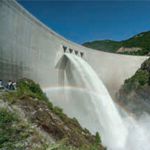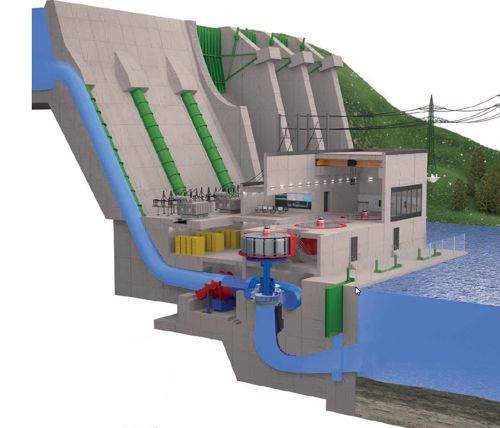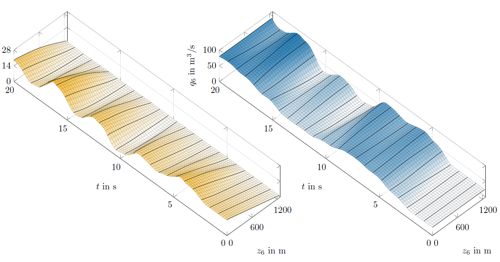
Regelung von Pumpspeicherkraftwerken
Projektschwerpunkte
- Entwicklung effizienter Modelle zur Beschreibung der Strömung in Druckrohrleitungen
- Entwicklung skalierbarer, physikalisch-basierter digitaler Zwillinge von Pumpspeicherkraftwerken
- Entwurf optimaler (modell-prädiktiver) Regelungsstrategien
- Untersuchung der Beobachtung von nicht messbaren Größen
Beschreibung
Durch den vermehrten Ausbau von erneuerbaren Energieerzeugungssystemen (Windkraft, Sonnenkraft) ist der Anteil an Kraftwerken mit stark fluktuierender Leistung in den europäischen Energieverteilungsnetzwerken wesentlich angestiegen. Um die Stabilität der Netzwerke zu garantieren sind daher entsprechende Speicher notwendig. Die am weitesten verbreitete Möglichkeit zur Speicherung von elektrischer Energie sind Pumpspeicherkraftwerke, die im Wesentlichen aus zwei Wasserbecken auf unterschiedlicher Meereshöhe bestehen, welche über Rohrleitungen und Turbinen miteinander verbunden sind, siehe Abb. 1. Wenn nun überschüssige Leistung im Netz vorhanden ist, so wird Wasser vom unteren ins obere Becken gepumpt. Umgekehrt wird Leistung ins Netz abgegeben indem Wasser vom oberen Becken über die Turbine ins untere Becken gefördert wird.

Typischer Aufbau eines Pumpspeicherkraftwerkes
In diesem Forschungsprojekt werden in Kooperation mit der Firma Andritz Hydro Regelungsstrategien für den optimalen dynamischen Betrieb von Pumpspeicherkraftwerken entwickelt. Es werden Anlagen mit konstanter Drehzahl (Synchronmaschine) und drehzahlvariable Anlagen (doppelt-gespeiste Asynchronmaschine oder Synchronmaschine mit Vollumrichter)betrachtet. Ein typischer Aufbau eines Pumpspeicherkraftwerks mit doppelt-gespeisten Asynchronmaschinen (DFIM) ist in Abb. 2 dargestellt.

Komponenten eines drehzahlvariablen Pumpspeicherkraftwerks
Eine wesentliche Schwierigkeit bei der dynamischen Regelung von Pumpspeicherkraftwerken sind die häufig sehr langen Rohrleitungen (im Bereich von bis zu einigen Kilometern), die die Turbinen mit den Becken verbinden. Bei schnellen Verstellungen der Turbine werden dabei Druckwellen angeregt, die sich in den Leitungen ausbreiten (Druckstoß) und zu einer hohen Belastung bis zum Defekt der Rohrleitungen führen können. Die Abb. 3 zeigt einen typischen Verlauf des Drucks und des Volumenstroms entlang einer Druckrohrleitung bei einem schnellen Schließen der Turbine.

Örtlicher und zeitlicher Verlauf des Drucks und Volumenstroms einer Rohrleitung
Um diese Effekte zu beschreiben werden in diesem Projekt Approximationen der infinit-dimensionalen Gleichungen hergeleitet, wobei ein besonderer Schwerpunkt auf eine möglichst hohe numerische Effizienz gelegt wird. Dies ist vor allem für den Einsatz der Modelle in modellbasierten Regelungsstrategien von besonderer Bedeutung. Auf Basis dieser Modelle werden optimale Regelungsstrategien, insbesondere modellprädiktive Ansätze, untersucht. Auf Basis dieser Modelle und den Modellen des elektrischen Systems wird ein skalierbarer physikalisch-basierter digitaler Zwilling (einschließlich Sensoren und Aktoren) entwickelt. Der physikalisch-basierte digitale Zwilling ermöglicht eine einfache Anpassung an verschiedene Topologien von Pumpspeicherkraftwerken (Anzahl der Rohrleitungen, Turbinen- und Generatortypen, verschiedene Elemente im elektrischen System) unter Verwendung von Konstruktionsparametern der Anlagen. Der digitale Zwilling dient auch zur Untersuchung optimaler Regelstrategien (modellprädiktive Regelung). Das Ziel ist dabei eine wesentliche Erhöhung der Regeldynamik (und damit des Potenzials für eine Stabilisierung von Schwankungen im Verteilnetz) bei Beibehaltung bzw. Erhöhung des Wirkungsgrads. Die optimale Steuerung hochdynamischer Transienter (z. B. Lastabwurf) wird ebenfalls untersucht.
Ein weiterer Schwerpunkt des Projekts liegt im optimalen Anlagebetrieb. Ein Aspekt ist die optimale wirtschaftliche Kraftwerksauslastung mittels Day-Ahead-Optimierungen und der Regelung kurzfristiger Überlastungen, um im Intraday-Handel zur Verfügung stehende Reserven zu vermarkten. Ein weiterer Aspekt ist der Kraftwerksbetrieb bei minimalem Verschleiß, um die Lebensdauer des Kraftwerks zu verlängern.
Ausgewählte Publikationen
- J. -F. Mennemann, L. Marko, J. Schmidt, W. Kemmetmüller, and A. Kugi, The spectral element method as an efficient tool for transient simulations of hydraulic systems, Applied Mathematical Modelling, vol. 54, p. 627–647, 2018.
[BibTex] [Download]@Article{Mennemann2018, author = {Mennemann, J.-F. and Marko, L. and Schmidt, J. and Kemmetm{\"u}ller, W. and Kugi, A.}, title = {{The spectral element method as an efficient tool for transient simulations of hydraulic systems}}, doi = {10.1016/j.apm.2017.10.010}, issn = {0307-904X}, pages = {627--647}, volume = {54}, journal = {Applied Mathematical Modelling}, year = {2018}, } - J. Schmidt, W. Kemmetmüller, and A. Kugi, Modeling and static optimization of a variable speed pumped storage power plant, Renewable Energy, vol. 111, p. 38–51, 2017.
[BibTex] [Download]@Article{Schmidt17, Title = {Modeling and static optimization of a variable speed pumped storage power plant}, Author = {Schmidt, J. and Kemmetm\"uller, W. and Kugi, A.}, Journal = {Renewable Energy}, Pages = {38--51}, Volume = {111}, Year = {2017}, Doi = {10.1016/j.renene.2017.03.055}, ISSN = {0960-1481}, } - J. -F. Mennemann, J. Schmidt, W. Kemmetmüller, and A. Kugi, Simulation von Welleneffekten in Pumpspeicherkraftwerken mit Hilfe der Spektral-Element-Methode, at – Automatisierungstechnik, vol. 64, iss. 8, p. 681–695, 2016.
[BibTex]@Article{Mennemann16, Title = {{Simulation von Welleneffekten in Pumpspeicherkraftwerken mit Hilfe der Spektral-Element-Methode}}, Author = {Mennemann, J.-F. and Schmidt, J. and Kemmetm{\"u}ller, W. and Kugi, A.}, Journal = {at -- Automatisierungstechnik}, Pages = {681--695}, Volume = {64}, Year = {2016}, Number = {8}, Doi = {10.1515/auto-2016-0061}, ISSN = {0178-2312}, } - J. Mennemann, J. Schmidt, W. Kemmetmüller, and A. Kugi, Anwendung der Spectral-Penalty-Methode zur effizienten Diskretisierung der Massen- und Impulsbilanzgleichungen in Rohrleitungssystemen von Pumpspeicherkraftwerken, in Tagungsband GMA-Fachausschuss 1.30 „Modellbildung, Identifikation und Simulation in der Automatisierungstechnik“, Anif/Salzburg, Austria, 2015, p. 56–95.
[BibTex]@InProceedings{Mennemann15, author = {Mennemann, Jan-Frederik and Schmidt, J. and Kemmetm\"uller, W. and Kugi, A.}, title = {{Anwendung der Spectral-Penalty-Methode zur effizienten Diskretisierung der Massen- und Impulsbilanzgleichungen in Rohrleitungssystemen von Pumpspeicherkraftwerken}}, booktitle = {Tagungsband GMA-Fachausschuss 1.30 "Modellbildung, Identifikation und Simulation in der Automatisierungstechnik"}, year = {2015}, month = {9}, isbn = {978-3-9815012-9-2}, pages = {56--95}, address = {Anif/Salzburg, Austria}, } - J. Schmidt, W. Kemmetmüller, and A. Kugi, Modellierung und Analyse eines Pumpspeicherkraftwerks mit drehzahlvariablem Generator, in Tagungsband GMA-Fachausschuss 1.30 „Modellbildung, Identifikation und Simulation in der Automatisierungstechnik“, Anif/Salzburg, Austria, 2014, p. 38–68.
[BibTex]@InProceedings{Schmidt14, author = {Schmidt, J. and Kemmetm\"uller, W. and Kugi, A.}, title = {Modellierung und {A}nalyse eines {P}umpspeicherkraftwerks mit drehzahlvariablem {G}enerator}, booktitle = {Tagungsband GMA-Fachausschuss 1.30 "Modellbildung, Identifikation und Simulation in der Automatisierungstechnik"}, year = {2014}, month = {9}, pages = {38--68}, address = {Anif/Salzburg, Austria}, } - L. Marko, J. -F. Mennemann, L. Jadachowski, W. Kemmetmüller, and A. Kugi, Early- and late-lumping observer designs for long hydraulic pipelines: Application to pumped-storage power plants, Int. Journal of Robust and Nonlinear Control, vol. 28, iss. 7, p. 2759–2779, 2018.
[BibTex]@Article{Marko2018, author = {Marko, L. and Mennemann, J.-F. and Jadachowski, L. and Kemmetm{\"u}ller, W. and Kugi, A.}, title = {{Early- and late-lumping observer designs for long hydraulic pipelines: Application to pumped-storage power plants}}, doi = {10.1002/rnc.4049}, issn = {1099-1239}, number = {7}, pages = {2759--2779}, volume = {28}, journal = {Int. Journal of Robust and Nonlinear Control}, year = {2018}, }
Projektpartner und Förderung
Ansprechpartner
Univ.Prof. Dr.-Ing. Wolfgang KemmetmüllerUniv.-Prof. Dr.techn. Andreas Kugi